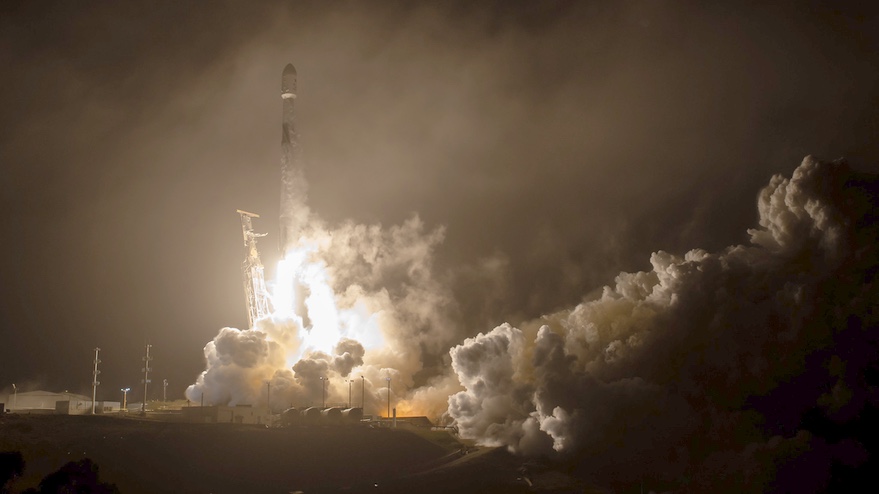WASHINGTON — A SpaceX Falcon 9 successfully launched a NASA mission that will deliberately collide with a near Earth asteroid to test a technique that could be used to deflect the trajectory of any future asteroid on a collision course with the Earth.
The Falcon 9 lifted off on schedule at 1:21 a.m. Eastern Nov. 24 from Space Launch Complex 4E at Vandenberg Space Force Base in California. The rocket’s upper stage deployed NASA’s Double Asteroid Redirection Test (DART) spacecraft about 55 minutes later, after two burns of that stage.
The rocket’s first stage landed on a droneship in the Pacific Ocean downrange from Vandenberg. The stage was on its third flight, having previously launched the Sentinel-6 Michael Freilich ocean science satellite a year ago and a batch of Starlink satellites in May. This was the first SpaceX launch for NASA’s Launch Services Program, which handles spacecraft missions like DART, to use a previously flown booster, although such boosters have been used extensively for NASA commercial cargo and crew missions.
DART is NASA’s first mission devoted to planetary defense. In September 2022 the spacecraft will collide with Dimorphos, a moon orbiting the near Earth asteroid Didymos, at more than 24,000 kilometers per hour. The impact will change the orbit of Dimorphos slightly, demonstrating how such a “kinetic impactor” could be used to change the trajectory of a threatening asteroid.
“We definitely have a reason to want to be able to see, by ramming this asteroid,” said NASA Administrator Bill Nelson in a Nov. 23 interview, “can you slightly move the trajectory. And if so, then we have a template for the future.”
DART is the first mission devoted primarily to planetary defense at NASA. “The DART project is part of a larger portfolio that we have for the planetary defense program at NASA,” said Lindley Johnson, NASA’s planetary defense officer and head of the Planetary Defense Coordination Office at the agency, during a Nov. 22 briefing.
That effort includes funding of groundbased observations and coordination with other agencies for planning in the event an asteroid on a collision course is detected. No known asteroid poses an impact threat to the Earth for the next century, but only about 40% percent of the estimated population of large near Earth asteroids has been discovered.
A second planetary defense mission, the Near Earth Object (NEO) Surveyor, is in development to fill those gaps. It is a space-based infrared telescope designed to accelerate the discovery of near Earth asteroids to help achieve a congressionally mandated goal of finding at least 90 percent of all NEOs at least 140 meters across. NEO Surveyor is scheduled for launch in 2026.
“It’s a whole program,” Nelson said of those planetary defense efforts, one that also includes international cooperation with organizations like the European Space Agency. “Everybody on Earth ought to, in their space agencies, have an interest in doing this.”
ASAT and Artemis updates
In the interview, Nelson said there were few new developments on two other major issues facing the agency in recent weeks. He said he had no additional direct contact with Roscosmos since a call with its head, Dmitry Rogozin, Nov. 16, a day after Russia conducted an antisatellite (ASAT) missile test that destroyed a defunct satellite. That test has created potentially thousands of pieces of debris and, in the first hours after the test, disrupted operations on the International Space Station.
The test, he said, will not adversely affect prospects for continued cooperation with Russia on the ISS. NASA is continuing to have discussions with Roscosmos about both the long-term future of the station as well as a near-term agreement to swap Soyuz and commercial crew seats. “We will continue to have those discussions and maybe have something to announce when I go over to Moscow,” he said, adding that no date has been set for him to meet with Rogozin there.
NASA announced Nov. 9 that it was delaying a key element of the Artemis program, a human return to the surface of the moon, from 2024 to at least 2025. Nelson, in a briefing then, said delays caused by a GAO protest and later lawsuit over the award of a lunar lander development contract to SpaceX as well as an original schedule that was “not grounded in technical feasibility,” caused the slip.
He said in the interview that there had not been much reaction from Capitol Hill about the schedule slip. “No more than the normal conversation,” he said. “I think everyone has pretty well understood that the first one, when announced, was done without it being technically feasible.” He added members of Congress also understood the effects of the lunar lander protest, as well as the pandemic, on the program.
He added he met recently with the Problem Solvers Caucus, a bipartisan group of members of Congress, briefing them on NASA’s activities. “They are excited,” he said. “Rather than being concerned, I think everybody’s excited about our space program now.”
